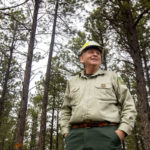As Black Hills beetle epidemic ends, resiliency project begins
Posted: April 24, 2017Source: Rapid City Journal

Hannah Hunsinger, JournalStaff
U.S. Forest Service officials said this month that the 20-year mountain pine beetle epidemic in the Black Hills has officially ended, but that doesn’t mean their fight against the tree-killing insects is over.
In fact, an effort to limit the damage from the next mountain pine beetle epidemic could begin soon.
The new effort is called the Black Hills Resilient Landscapes Project, and the project manager is Anne Davy of the U.S. Forest Service. She said the millions of tree deaths during the pine beetle epidemic knocked conditions in the Black Hills National Forest “out of whack.”
“When the infestation was so bad, we just needed to stop it,” Davy said. “We went out and dealt with that, and now we need to start moving things back in the right direction.”
If the project is approved, forest managers will spend the next decade working to make the forest more resilient to beetles and wildfires. The work will vary depending on local conditions, but it will include removing some dead trees, igniting controlled burns, thinning dense areas to act as breaks against wildfires, cutting encroaching pines out of aspen and oak stands and away from grassy meadows, culling some old or young pines to encourage a healthier mix of tree ages, and churning up some patches of soil to facilitate new tree growth.
“We’re really investing in the long-term health and resiliency of the forest,” Davy said.
Gale Gire, the Resilient Landscapes Project silviculturist (one who protects a forest), said one of the goals is to develop an array of diverse patches of forest, each characterized by different tree ages and sizes and stand densities, to break up the tall and dense stands of pine trees that beetles thrive on.
“If there’s a complete sea of the same type of trees, they can really go to town on that,” Gire said.
Mountain pine beetles have been “going to town” on the Black Hills since 1997 when the beetle epidemic began. About 448,000 acres have been affected by beetles since then, which equates to more than one-third of the total acreage of the Black Hills National Forest. Large swaths of forest, now left brown or barren, were affected.
But the recently announced results of an aerial survey conducted last fall showed only 2,500 newly affected acres in 2016. That was a drop from 17,000 newly affected acres the previous year, and it signaled a return to a normal — rather than epidemic — level of beetle infestation.
The beetles, which are black in color and about the size of a grain of rice, burrow through the bark of pine trees. They carry a harmful fungus and produce hungry larvae that combine to ravage a tree, causing it to turn brown and die within a year.
Millions of federal, state and private dollars have been spent on public and privately owned land during the past two decades to monitor the epidemic’s size, remove dead and dying trees, thin out the dense pine stands that beetles prefer, and treat some vulnerable trees with pesticides.
Mark Van Every, the supervisor of the Black Hills National Forest, reflected on the cooperative efforts in a recently written statement about the end of the epidemic.
“I appreciate the work by all and look forward to working together to make the forest more resilient into the future,” Van Every said.

